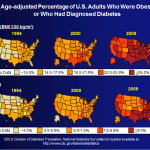By Dennis Harper, DO, Isagenix Scientific Advisory Board Chair
Those of you who read my last report on obesity know the Centers for Disease Control and Prevention (CDC) has a map showing the increase in obesity rates on a state-by-state basis since 1985. They also have a similar map related to diabetes rates. I have included the link here and suggest it is very worthwhile to review. The set of slides is a comparison of diabetes and obesity trends, but they have only correlated these statistics beginning with 1994. It would have been more enlightening to view the comparison of statistics beginning with 1985.
What is very interesting is the high correlation between obesity and diabetes trends. It is important to understand that almost all obesity-related diabetes (“diabesity”) is considered type 2. Most doctors’ first line of therapy will be diet and exercise. If diet and exercise does not work for the patient, doctors will add oral medications to increase the amount of insulin being produced or medications to increase the receptors’ ability to absorb glucose. In many instances they will use both.
When the above therapy fails, doctors then add injections of short, medium or long acting insulin. When the lab work of the patient with diabetes shows a failure to control glucose with just diet and exercise, the second phase of therapy is instituted. The medications to increase insulin should only be used if your doctor has checked to see if your fasting insulin levels are low. If they are not, then it would be better for your doctor to be using medications to increase receptor activity.
As a final resort doctors will add insulin if the patient cannot control the glucose levels. However, the more insulin you take generally makes the receptors less receptive to glucose so the remaining amount of glucose in the blood will be changed into triglycerides and stored as fat. This is the main reason why patients being treated for diabetes will frequently continue to gain weight, which makes this condition worse.
Unfortunately, in 2010, diabetes became the seventh leading cause of death. It is now estimated that 18.8 million people have been diagnosed with diabetes, seven million more are undiagnosed, and 79 million have prediabetes. Diabetes causes heart disease, high blood pressure, nervous system disease, strokes, lower limb amputations, blindness, certain types of cancer, and is the leading cause of kidney failure. The total estimated cost of diabetes in 2007 was 218 billion dollars.
Weight management with a healthy diet and exercise is key to battling back against the rise of diabetes. I personally always suggest that my patients exercise and switch their diets to a more diabetic-friendly diet—one that is lower in calories, lower in high-glycemic carbohydrates, and high in quality protein and healthy fats.


No comments:
Post a Comment